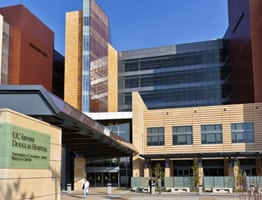
An Antibiotic Loophole?
A new study performed by the University of Michigan shows that while some hospitals are working to reduce antibiotic prescriptions made in-house—specifically, prescriptions for fluoroquinolones—those same hospitals were twice as likely to discharge patients with one of the antibiotics in that same group.
Hospitals across the nation are increasingly working to reduce the rate that risky antibiotics are prescribed to patients. Fluoroquinolones have been linked to the rise of drug-resistant organisms, Achilles tendon ruptures, low blood sugar in diabetic patients, and mental health complications. The U.S. Food and Drug Administration has even released warnings about the prescription of fluoroquinolones, indicating that they should not be prescribed to patients who are elderly, have high blood pressure, or are at risk for aneurysms.
The researchers used data from the Michigan Hospital Medicine Safety Consortium to look at patients treated for a urinary tract infection (UTI) or pneumonia over a two-year period.
One-third of the patients received a fluoroquinolone prescription at discharge. Across all 48 hospitals in the study, discharge-related prescriptions represented two-thirds of the entire fluoroquinolone supply that was prescribed to nearly 12,000 patients (treated for a UTI or pneumonia).
The study highlights the focus that healthcare providers need to place on selecting the best antibiotic for each patient, especially in hospitals that have already committed to reducing these types of prescriptions.
The study’s findings were reported in the journal Clinical Infectious Diseases.

Three Types of Urological Reconstruction
The purpose of a reconstructive surgical procedure is to restore the appearance and primary functions of any aspect of the structures and organs within the urinary system.
The results that you should expect to see from this surgery depend on a variety of factors, which mainly include overall health, the type of procedure that’s being performed, the reason that the surgery is taking place, and if the problem in the urinary tract was caused by some sort of underlying condition.
The doctor will be able to address any of the risks pertaining to the reconstructive procedure. Like with most surgeries, the risks to keep in mind include swelling, bleeding, and infection at the incision site.
Examples of Reconstructive Surgery
There are a range of conditions in the urinary tract that can be effectively treated by reconstructive surgery, including hypospadias, hidradenitis, and penile curvature.
- Hypospadias is a type of birth defect that results in the opening area of the urethra being positioned on the under portion of the penis as opposed to the tip of it. If the condition is too severe, the base area of the penis may be adversely affected, which may require a reconstructive surgery that uses tissue grafts. The affected individual should be able to urinate properly once the surgery has been administered.
- Hidradenitis is a chronic disease that causes the development of bumps along the skin within the groin area. These bumps can be painful. The condition is believed to be caused by certain blockages around the hair roots. While medication will likely be able to effective manage the symptoms that you’re experiencing, reconstructive surgery can be used to remove the portions of skin that are affected by the condition.
- As for penile curvature, reconstructive surgery is typically only used if the curvature is severe. While this condition can present itself as a condition that occurs somewhat late in a person’s life, standard penile curvature is a congenital issue. Reconstructive surgery is used to properly adjust the length of the tissue that’s found opposite from the curvature. The results should lead to the shape and length of the penis being equal.

Understanding Neurogenic Bladder
Being able to use the bathroom normally may be a physical capability that some people take for granted. However, people who suffer from neurogenic bladder often cannot control this bodily function. They must seek out medical treatment to ease or eliminate the symptoms and complications that can come with having a neurogenic bladder.
What is a Neurogenic Bladder?
A neurogenic bladder is a condition that is caused by an underlying illness or injury to the body or brain. It is also known as dysfunctional voiding or voiding dysfunction. It can affect both men and women regardless of their age.
The symptoms of neurogenic bladder can vary. However, the most common ones include:
- Urinary incontinence
- Urinary retention
- Pelvic pain
- Urinary tract infections
- Deterioration of kidney function
People who are suspected of having this condition are typically subjected to a number of diagnostic tests to determine whether or not they truly have neurogenic bladder. The tests can include urodynamics, a cystoscopy, renal ultrasound, or a CAT scan to examine the health and function of the kidneys.
A neurogenic bladder can be treated a number of different ways. The prescribed treatment will depend on the underlying cause of the condition.
Causes of Neurogenic Bladder
A number of different factors can cause the development and persistence of a neurogenic bladder. Some of the most common causes of this condition include:
- Brain tumors
- Cerebral palsy
- Multiple sclerosis
- Strokes
- Dementia
- Parkinson’s disease
- Trauma
- Diabetes
In some instances, treating an underlying cause like diabetes could remedy some or all of the symptoms of neurogenic bladder. Alternatively, treatment for the underlying cause may involve treating the neurogenic bladder at the same time as the primary cause.
Neurogenic Bladder Treatments
The types of treatments for neurogenic bladder all are designed to ease as much as possible either the symptoms of this condition or the underlying cause contributing to them. For some people, remedying this condition could be as simple as retraining the bladder or engaging in pelvic floor exercises. These exercises increase support for the bladder.
Other patients may fare better receiving sacral nerve stimulation or SNS, which is designed to rewire the signals from the brain to the bladder. If SNS does not work, people could receive Botox injections that will calm the muscles of an overactive bladder.
Doctors also commonly prescribe medications like anticholinergics, which relax the nerves and muscles around the bladder. They also prevent urine leakage and allow people to go longer in between visits to the bathroom.
When all of these possible remedies do not work, patients may need to undergo surgery for neurogenic bladder. The surgery could involve extending the size and holding capacity of the bladder by enlarging it with a piece of the bladder. Alternatively, the surgeon could create a stoma so urine can be drained through the abdominal wall.

Undescended Testicles in Newborn Boys
During the last few months of pregnancy, the testicles of soon-to-be-born males normally move lover into the abdomen and down to the pouch just below the penis, known as the scrotum. In some cases, one or both testicles will fail to move into place in the scrotum. When this happens, it’s referred to as an undescended testicle, an abnormality also called cryptorchidism.
While more common in prematurely delivered boys, it can occur in any newborn male. The testicle that hasn’t descended usually does so within the first six months of life. If this doesn’t happen, surgery is usually necessary.
Possible Causes
There is often no clear reason why a testicle sometimes fails to move into its proper position before birth. It’s believed that the abnormality may have something to do with genetics or outside influences that could affect hormones and other biological processes during pregnancy. In some instances, a blockage occurs that prevents a testicle from descending. Cryptorchidism may also occur in boys born to mothers who:
- Are significantly above their normal weight
- Have either preexisting issues with diabetes or develop it during pregnancy
- Consume alcohol or smoke during pregnancy
Certain inherited genetic defects could also play a role in the odds of having a boy born with this abnormality. Additional contributing factors may include Down syndrome and similar conditions that can have an impact on fetal development.
Some boys have what’s termed a retractile testicle that moves back and forth from the groin to the scrotum. If this happens, it may be assumed that both testicles have descended normally during an initial examination after birth. In rare cases, a testicle that did descend into place will go back into lower abdomen or groin. It’s not clear why this happens.
Signs of a Problem
The most common sign of an undescended testicle is not being able to feel one during normal cleaning or bathing routines. Other times, the scrotum may appear smaller in size and shape than what’s considered normal, or one side may appear flat. If not diagnosed and treated, an undescended testicle may increase the odds of developing testicular cancer or having fertility problems.
Making a Positive Diagnosis
The problem is usually detected shortly after birth or during regular pediatric exams. The diagnostic process typically includes eliminating other possible conditions such as ectopic testicles that didn’t fall into place or retractile testicles that are moving in and out of their correct position. A laparoscopy may be done to locate the undescended testicle. It’s a procedure involving a small incision in the lower abdomen. With some boys, open exploratory surgery may be necessary to locate the testicle and identify any related issues.
Treatment Options
If an undescended testicle is discovered at birth, the only “treatment” is usually periodic observation to see if the affected testicle naturally moves into the correct position. When surgery is necessary, it’s usually a procedure called an orchiopexy that involves manipulating the misplaced testicle and sewing it into the correct position to prevent it from moving again. An alternative treatment recommendation is the use of hCG (human chorionic gonadotropin) hormones to induce testicle movement if surgery isn’t fully successful.








